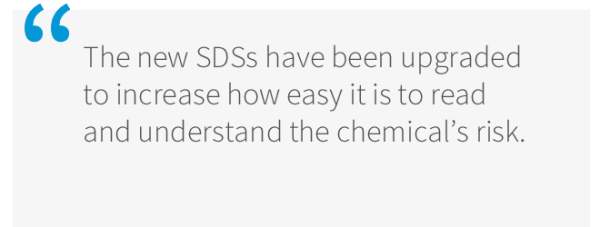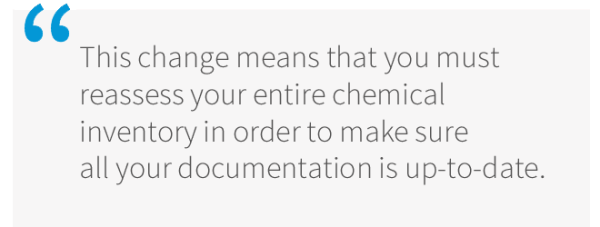.webp?width=320&name=SDS_NOTICE(1).webp) OSHA’s adoption of the Globally Harmonized System (GHS) via HazCom 2012 is bringing some significant changes to the long-standing MSDS that American manufacturers are used to.
OSHA’s adoption of the Globally Harmonized System (GHS) via HazCom 2012 is bringing some significant changes to the long-standing MSDS that American manufacturers are used to.
As North America transitions to using the GHS guidelines for hazard communication in 2015, you’ll notice that the way industries are talking about and documenting the risks associated with chemical products is changing. These changes are perhaps most evident on the new GHS SDS, which replaces the MSDS format. Although many MSDS elements can be found in the GHS SDS, new sections and types of information have been added to make the SDS more useful and place a greater emphasis on effective communication and comprehension.
This short primer article will give you a breakdown of the new SDS sections so that you’ll be prepared to read, understand, or author your own GHS SDSs.
Hazard Communication History: What was an MSDS?
Since OSHA established its 1994 Hazard Communication guidelines, the 8-section MSDS has been the most commonly used MSDS format across the United States.
The main purpose of the MSDS was to accompany hazardous chemical shipments in order to inform users and transporters about the specific dangers that product could present. MSDSs include information about safe handling procedures, proper storage and disposal practices, and what to do in case of accidental exposure.
The 1994 guidelines contained an Employee Right-to-Know provision that states that employees have a right to understand the risks associated with the chemicals they may be exposed to in the work place. For this reason MSDSs were required to be readily accessible on site, and kept updated with the most accurate data available. In addition, employees need to be trained and educated about chemical hazards and precautions.
Chemical manufacturers, distributors, and importers are the most involved groups in the authoring and evaluation of MSDSs. However, any business that uses chemical products must be able to read and understand MSDSs both for their hazard communication information and for their environmental impact information.
The new Safety Data Sheets carry on the same mission of the MSDS, but have been upgraded to increase how easy it is to read and understand the chemical’s risks. This means there are more sections and more streamlined phrases present on a SDS.
What Information does an SDS Contain?
At first glance you’ll notice that an SDS contains a great deal more information than the standard MSDS. An SDS contains 16 sections, double what the MSDS contained. However, much of the information is the same or similar were you to compare an MSDS and SDS side by side. The SDS re-formatting is designed to promote consistency and user-friendliness.
Below is a brief summary of what each SDS section communicates. More details about the minimum information required for each section can be found in the HazCom 2012 Appendix D.
Section 1: Identification includes product identifier; recommended use of chemical; restrictions on use; manufacturer or distributor name, address, phone number; emergency phone number.
Section 2: Hazard(s) identification includes all hazard classification regarding the chemical; required label elements (product identification, signal word, hazard statements precautionary statements, pictograms, supplier identification, and supplemental information). One of the biggest changes under the GHS is the way that chemicals are classified and categorized. The GHS uses a standardized set of hazard categories and hazard classifications, each of which has a specific set of guidelines to determine which ones apply to your chemical product. ERA has a useful guide about GHS Classification and GHS Categorization coming up soon.
Section 3: Composition/information on ingredients includes information on chemical ingredients: substances, mixtures and chemicals with trade secret claims.
Section 4: First-aid measures include necessary first-aid instructions; description of important symptoms, acute or delayed.
Section 5: Fire-fighting measures list suitable extinguishing techniques, protective equipment; chemical hazards from fire.
Section 6: Accidental release measures list emergency procedures; protective equipment; proper methods of containment and cleanup.
Section 7: Handling and storage lists precautions for safe handling and storage, including incompatibilities.
Section 8: Exposure controls/personal protection lists OSHA’s Permissible Exposure Limits (PELs); Threshold Limit Values (TLVs); appropriate engineering controls; personal protective equipment (PPE).
Section 9: Physical and chemical properties lists the chemical’s characteristics (Density, % VOC, % HAPS, Appearance etc.)
Section 10: Stability and reactivity include chemical stability and possibility of hazardous reactions.
Section 11: Toxicological information includes routes of exposure; related symptoms, acute and chronic effects; numerical measures of toxicity.
Section 12: Ecological information* includes adverse effects to the environment, particularly aquatic and terrestrial ecotoxicity, bioaccumulative potential and degradability.
Section 13: Disposal considerations* describes safe handling of waste residue and methods of their disposal
Section 14: Transport information* includes UN number and proper shipping name, transport hazard class and any specific precautions to comply with while transporting.
Section 15: Regulatory information* includes safety, health and environmental regulations that apply specifically to the chemical product
Section 16: Other information includes the date of preparation or last revision.
*Note: OSHA does not enforce Sections 12 through 15 (29 CFR 1910.1200(g)(2)) since this information is regulated by other Agencies.
The above sections are contained in the new GHS SDS format. To see a comparison of SDS elements against older MSDS Elements can be found online on the OSHA Website.
What does this Mean for your Business?
The switch from MSDS to SDS format is expected to increase your workplace safety and make it easier for your business to properly use, store, and dispose of the chemicals you use. However, the transition will also require employers to update their chemical inventory management systems. That work will require time and research, and OSHA is encouraging businesses to get started today – the sooner the better. In fact, December 2013 already contained an OSHA deadline to make sure all employees were trained in the new SDS format.
This change means that you must reassess your entire chemical inventory in order to make sure all your documentation is up-to-date. This involves working with chemical vendors to ensure all the data is correct, that you have the most recent revision date data, and then using that information to ensure everything is properly classified and categorized according to the new GHS standards. If you simply use chemical materials, there will be less work for you, but if you are in any way responsible for authoring SDS or labels for chemical containers (including secondary chemical containers) you will also need to start replacing your MSDS authoring with SDS authoring. Most manufacturers are investing in a GHS SDS authoring system to handle this difficult task for them to ensure they don’t lose money or make mistakes during the GHS implementation.
You do not need to keep an MSDS and an SDS of the same product on hand. Instead, archive old MSDSs as they get replaced by SDSs. Incoming SDSs will need to be checked against the older MSDSs to see if there are any new hazards or precautions: this is important because some chemicals that you might have been using for a while may have undergone changes in classification via the GHS and could require new handling recommendations and updated training.
SDSs contribute to healthier and more productive workplaces. However, as with any regulatory change, the transition window presents certain risks. In order to mitigate those risks and simply enjoy the GHS’s benefits, now is the time to start looking for a better system to manage your incoming SDSs, track chemicals as they move through your facilities, and author SDSs and labels.
If you're looking for ways to improve your SDS management system, download our detailed guide that will walk you through the process.
Free On-Demand SDS Authoring Webinar
Want to learn more about what goes in to each section of an SDS and how the information plays a vital role in preventing injuries and mitigating risk? ERA is providing an on-demand free webinar that will give you a deep-dive into SDS sections, SDS authoring, and how it all relates to Health & Safety compliance.
- Differences between OSHA, CLP, and WHMIS
- Dos and Don'ts for SDS Authoring
- How to keep up with changing GHS standards around the world.
Click the button below to access the on-demand SDS webinar.
Ask an ERA Expert:
Are you transitioning to the GHS in your business? Do you have any questions or concerns about the topic covered in this article? Want more insight? Now is your chance to ask one of ERA’s Environmental Specialists. Please leave your question or comment below and we’ll make sure one of our expert scientists responds.
This Blog was Co-Authored By:


April 9, 2014





Comments